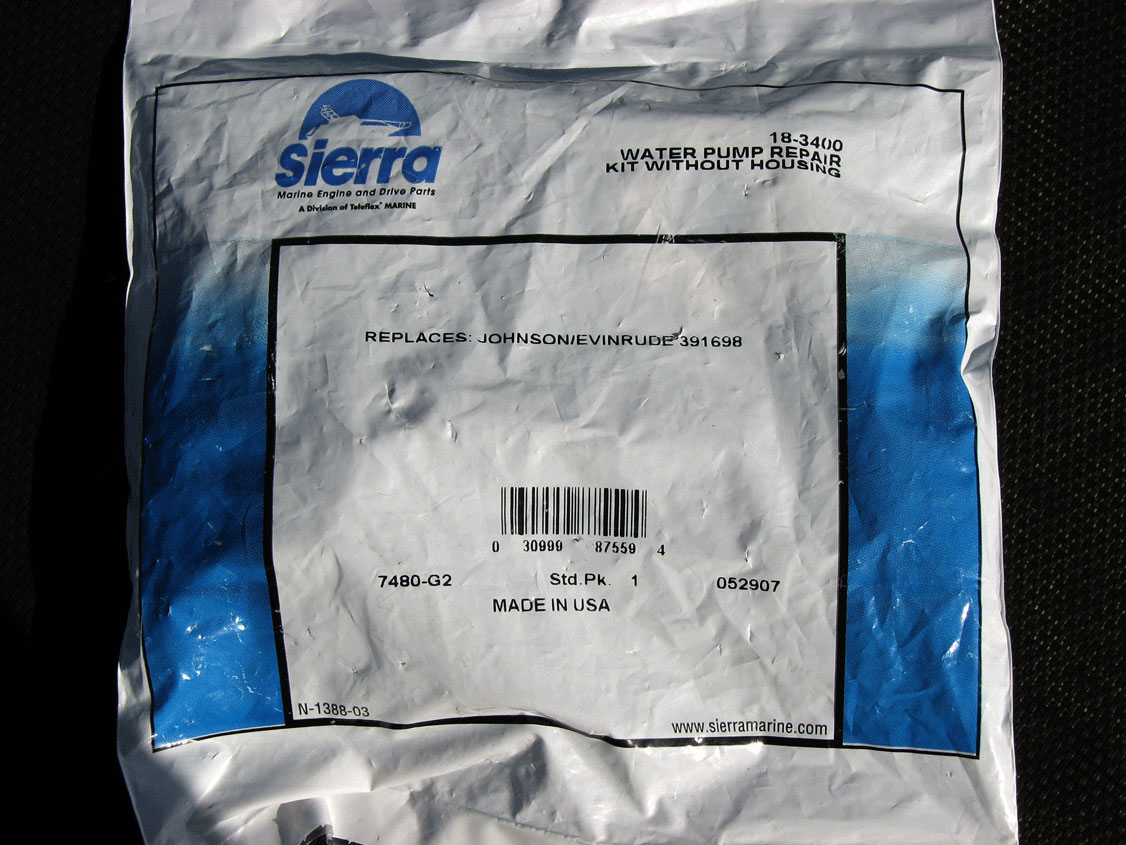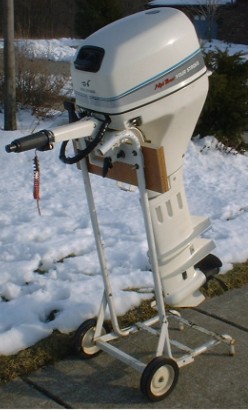 Many owners store a three
gallon tank and run their fuel line out a hole drilled in the rear giving them
a straight shot to the outboard. I run a large 9.9 motor where most owners run
less than six horsepower motors.
Many owners store a three
gallon tank and run their fuel line out a hole drilled in the rear giving them
a straight shot to the outboard. I run a large 9.9 motor where most owners run
less than six horsepower motors.If you have the same motor I do, here is the aftermarket water pump kit it takes.


Back in racing days, engines that had lots of cubic inches had lots of low-end torque! After doing a little research on my 1998 OMC Johnson 9.9hp, 4 stroke, electric start outboard, I became very thrilled to find out it's power range starts much lower than the Mariner, Yamaha, or Honda. The engine makes torque where Sailboats need it most, at lower RMP's. You ask why all that matters, well I'll tell you.

1) The pistons are slower and at least in theory, the rings will last longer. Of course this matters very little since I average three hours run time a year. That's about six years of service before I complete the factory suggested 20 hour break-in period. (What do you expect, it's a sailboat!)
2) The power being made at lower RPM's means that I can shift from forward to reverse without the need to wait while the engine decelerates. That gives me additional control around the docks where a sailboat really needs it! *(We all know how much a fraction of a second matters in a panic situation!)
3) Having lots of low-end torque also means the factory had no problem putting a four blade prop on it as standard equipment since that blade generally needs more torque. If you notice in picture #1 each blade is round, affectionately called "Mickey Mouse ears". That is the preferred shape for sailboats. Around the dock you'll generally want equal amounts of forward and reverse thrust. Yea, I know about the pitch and diameter formulas but if you change that, you'll end up screwing around with all the "numbers"!
4) It has several "goodies" that other manufactures are starting to copy.
5) The OMC 9.9hp has been around for awhile. Bugs have been "chased away" long ago.
If you can't already tell, I love my outboard! It's a great addition to my Santana 2023!
Side Note: In 2001 Bombardier purchased OMC.


Sometime in the past, my dealership had mounted an outboard motor. The brackets hold on to a raised portion of body-work and was loosely holding on at the lower portion. The end result was a big chip. After I received my new outboard, the same thing was about to happen to me.
As I looked the situation over it became apparent that the upper molding was being pinched by the motor's brackets. A simple modification was in order.
Taking my little Dremel motor, I ground out a small overlapping deck section that was interfering. (Note: Arrow is pointing to it in picture.) Then I inserted the 3/8" thick painted plywood and mounted the motor. As I did, I inserted small patches of industrial anti-vibration material on the inside.
Looking carefully, you'll also see one of the two bolts used to help steady the motor and stop the honest crooks from thinking about taking my motor.
All told it took about a half hour and it looks good to me.
It's a natural! The starboard lazarette being that it easily holds my six gallon gas tank while still being fairly easy to lift out when refueling it.
 Many owners store a three
gallon tank and run their fuel line out a hole drilled in the rear giving them
a straight shot to the outboard. I run a large 9.9 motor where most owners run
less than six horsepower motors.
Many owners store a three
gallon tank and run their fuel line out a hole drilled in the rear giving them
a straight shot to the outboard. I run a large 9.9 motor where most owners run
less than six horsepower motors.
At least two, three-inch diameter breather holes are required for enclosed fuel tanks on boats that have built-in fuel storage from the factory. This is for proper ventilation to prevent buildup of fuel vapors. For safety, I put two in mine also. (Note positions "A" and "B"). The covers were less than ten bucks each. (End of season sale price.)
Location "A" is just an air vent that I hope is for intake and "B" for exhaust. This also allows me to fish the fuel line out towards the motor. Sorry about the difficult-to-see picture.
When I first purchased my sailboat, the dealer it was a "show 'n tell" boat and had a 15 HP two-stroke engine on it. A few weeks later when I went to pick it up, the engine had disappeared never to be seen again. To make amends, the dealer ordered the outboard of my choosing and at dealer cost! Not preferring two-strokes I looked into four strokes and with electric start. During the time it was being delivered to me, I prepared my Santana 2023 to accept the wiring and battery for it's electric starting feature.

The wires had to travel 25 feet from outboard to battery and should be a marine grade. Marine grade generally always means bigger bucks!
The engine came with twin 8-gauge wire but that was only about six feet long. Calling the factory I found out that 8-gauge was only accepted for up to 15 feet in length. Knowing that longer wires looses voltage from internal resistance, I asked what was needed for my 25 foot run. For the correct sizing they told me I'd need four gauge wire. Holy cow, that's fat stuff!
Two problems with twin 4-gauge wire, it can be used for a small sailboat's ballast and the final price would be close to the cost of a tender! Six gauge wire was okay to use up to 22 feet long so I figured that to be fine. Now to find some I could afford.
Asking around, I was turned on to brand new welding wire from a commercial electrical contractor. It seems many commercial installations require several hundred feet or more at a time with no splices or connections. They sold me the leftovers. Fifty feet was the correct length and price was much better but now I had to fish it through the interior of my boat.
Having worked with electrical wiring before, I knew that when possible you start from the end with no power then hookup to the power. That is what I did, from stern to battery!
Thank goodness the 2023 has a small ledge running the length of the interior but unless you've done it you have no idea how uncomfortable the interior stern section gets in a Santana 2023 on a hot, sunny, summer-like day until being there yourself for several hours.
Well I finished the project and tucked the wire away so it is almost not seen. It looks like the factory installed it! Great job if I do say-so myself!
Talking to other owner, no one has heard of an electric start outboard on a 2023. I guess my boat's a one-of-a-kind speciality!

What can I say? The picture shows you my very inexpensive motor holder I basically use in the winter. It is made from an old RC Cola pop bottle hauler I found at a garage sale for a buck. All I did was put a piece of wood near the top to simulate the transom mount.
Besides using it for a movable vertical holder, it works great for simple motor maintenance. Just haul it like a wheel barrel to a work space.
*Note that I've removed the "Johnson" label on the engine cowling. My personal opinion is that the lettering was too large and detracted from the boat's name.
Pictures of my motor data specs.


Specifications:
Exclusive:
Additional Features:
| Competitive Advantages (1998) | ||||
| Features | Johnson 9.9 | Honda 9.9 | Marcury 9.9 | Yamaha 9.9 |
| Larger engine (More low-end grunt!) | 305cc | - | 232cc | 232cc |
| Fresh water flushing port (Being copied by others.) | X | - | n/a | n/a |
| S.L.O.W. (Being copied by others.) | X | n/a | n/a | n/a |
| Standard Fuel Tank | 6 Gal. | 3 Gal. | 3 Gal. | 3 Gal. |
| High Thrust and X-long 25" shaft available | X | n/a | n/a | n/a |
Optional Equipment

Most outboard engines are similar, so I took a few shots of my OMC 9.9hp four stroke. For those who think a piston is a player on a Detroit, Michigan basketball team, take heart this article will be very-very short, simple and show you where some things are!
Simply put, in a gasoline four stroke engine, air travels in the intake and goes past the carburetor picking up some fuel. It then enters the combustion chamber. The fuel/air mixture is ignited by a spark plug and burns. As it burns, heat is produced and pushes the piston downward. As the piston moves, it is mechanically linked to other internal "things" which eventually turn the propeller. The piston moves back up and pushes the burned fuel/air mixture out the "tail-pipe". As the piston coasts back downward it pulls in more air and the process starts over.
The four strokes of a 4 stroke engine are: Stroke #1=Piston moves down drawing in air and fuel. Stroke #2=Piston coasts up and compresses the fuel/air mixture. Stroke #3=Spark ignites the compressed mixture to burn pushing the piston downward, (this is the power stroke). Stroke #4=Piston goes back up and pushes the burnt mixture out the exhaust. That's all four strokes. (Hows that for simple?)


Looking again at pictures 1, 2, and 3, you'll see the general layout of my outboard.
As a side note; it's the little things that help make my motor great. Look in pictures #2 & 3. The easy to see yellow oil dip stick and yellow motor oil fill cap, they both float! I don't recommend checking your oil while in the water but some owners leave their 2023's tied up dock side and have no choice. Should the worst happen and they end up overboard, it's wonderful to know you don't need to go diving underwater.
One more thing, starting the engine. The best way is with the electric start feature, as seen in picture #2, (the start button is by the tiller). Should your battery go bad, there is the pull start rope on top. If the pull start rope breaks, you can remove the flywheel cover and wrap something around the flywheel to fire it up. Examples are extra sheet line, anchor line, even your belt!
Return to Home Port.
Mail to: The WebCaptain1@yahoo.com